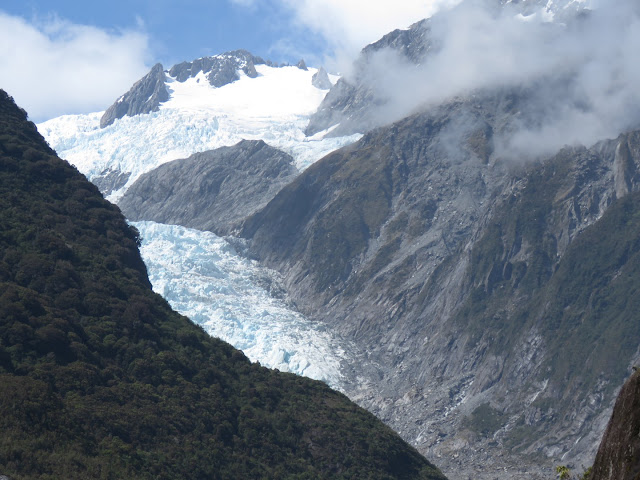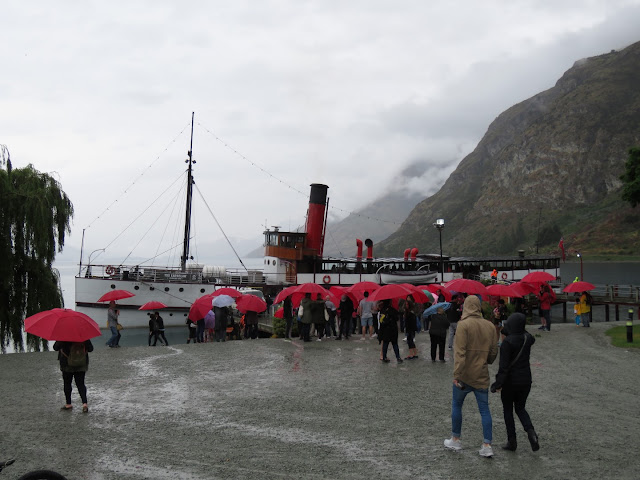Finally, we got a break in the miserable weather, just for one day, but, it allowed us a good day to have a look at the Franz Josef Glacier area. We drove the Haast Pass Highway, another spectacular mountain pass route which offered up beautiful vistas along with many waterfalls and other features like these lovely Blue Pools in which you could see brown trout suspended as if in midair.
The glacier itself, although much receded, was a pretty sight on a sunny day. It actually was quite puny-looking compared to many others we've seen in places like
Greenland,
Svalbard,
Alaska. and
British Columbia. So, when we arrived at the car park to find it was totally full to overflowing, no parking spot available and with hordes of people all milling about, we didn't feel bad about deciding to skip the hike to the terminus of the glacier that we had planned on.

Instead, we continued on to Franz Josef Glacier village and to the West Coast Wildlife Centre. We had hoped to see kiwis in the wild, especially on our visit to Stewart Island, but, after our unfortunate experience with the weather there, we'd given up until we got here. There are a few commercial places in NZ where kiwis can be seen. We try and avoid those so as not to encourage keeping captive animals for display purposes and profit. The West Coast Wildlife Centre is actually a joint venture between private enterprise and the Department of Conservation to run a breeding program to build up the numbers of a very endangered bird. There were just three juveniles and a chick on display and they will all be placed in the wild at the appropriate time in their development. We watched the three juveniles snuffle about in their "darkhouse" where a nocturnal forest environment is simulated.
Kiwis are a curious bird, but, we didn't realize just how fascinating they were until we took the "backstage tour" and met a ranger who described the birds and the successful breeding program that is in operation here. It's very intensive. Eggs are removed from the wild, incubated and hatched. The young birds then go to outdoor pens in Christchurch for a while. From there they are taken to offshore islands (predator-free) where they are left to grow until they are better able to fend for themselves at around ten months and 1kg in weight. The birds are recaptured and then released to the wild, with a radio transmitter so they can be tracked and monitored. There are five different species of kiwi and the Rowi is the species that is being so actively managed at this Centre. They only exist in the wild in a small pocket of forest in the Okarito sanctuary, close to Franz Josef Glacier. Their numbers were down to only about 150 birds and declining before this rescue effort was started. There are now about 400 birds.
Here are a few fascinating facts about kiwis taken from the brochure we were given on the backstage tour:
- Kiwis have many strange characteristics and are often referred to as an 'honorary mammal'.
- Flightless and nocturnal.
- Ground dwelling.
- Marrow filled bones (birds that fly have air filled bones to make them lighter). [This was demonstrated when the ranger handed around anatomically-correct models of the birds. The adult bird had a large, rounded body about the size of a bowling ball and was surprisingly very heavy.]
- Body temperature the same as humans.
- Strong sense of smell which they use to find food underground and in leaf litter. They also have sensory pits at the tip of their bill which can feel movement of bugs in the soil.
- Kiwi are the only bird in the world to have their nostrils at the tip of the bill, all other birds have them up at the base.
- Kiwis live 50-70 years.
- They are monogamous (one partner for life) and won't start breeding until 4 or 5 years old.
- Kiwi will naturally lay 1-4 eggs in a year and the male does most, if not all, of the incubation (depends on species). A kiwi egg can weigh 250-500g.
- Kiwi lay huge eggs - about 20% of the female's bodyweight! This is the equivalent of a human female giving birth to a six year old child.
[Here's a kiwi egg next to a chicken egg.]
[This is an x-ray of a kiwi four days before laying the enormous egg.]
- Kiwi eggs are incubated for about 80 days, the longest for any bird in the world.
- Chicks hatch fully feathered and can be independent as young as 2 weeks old.
- Kiwis defend themselves with sharp claws and strong legs. Their legs comprise almost a third of their body weight. They can outrun a human.
We couldn't take pictures of the live birds, but, here are two stuffed examples.

























